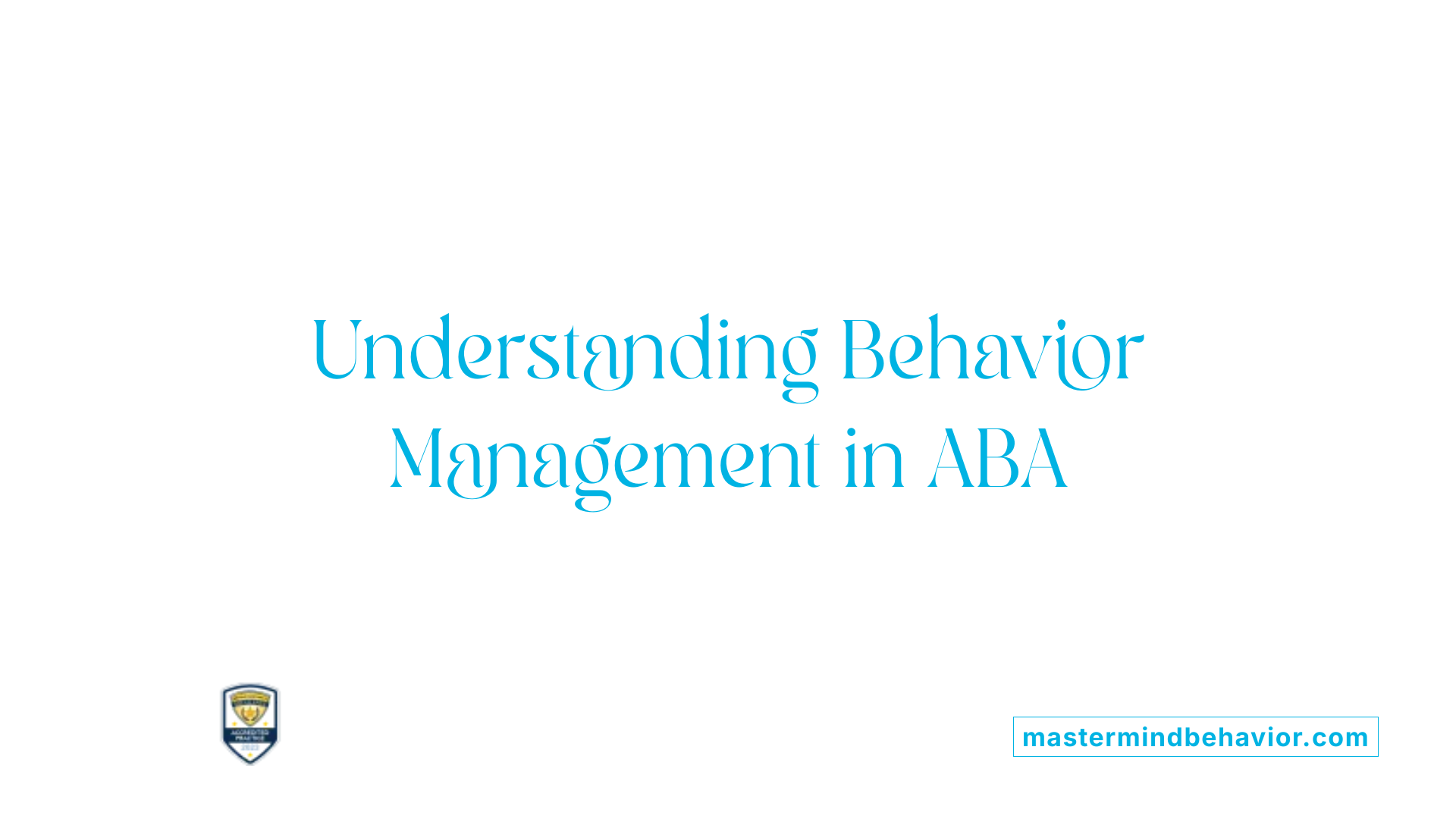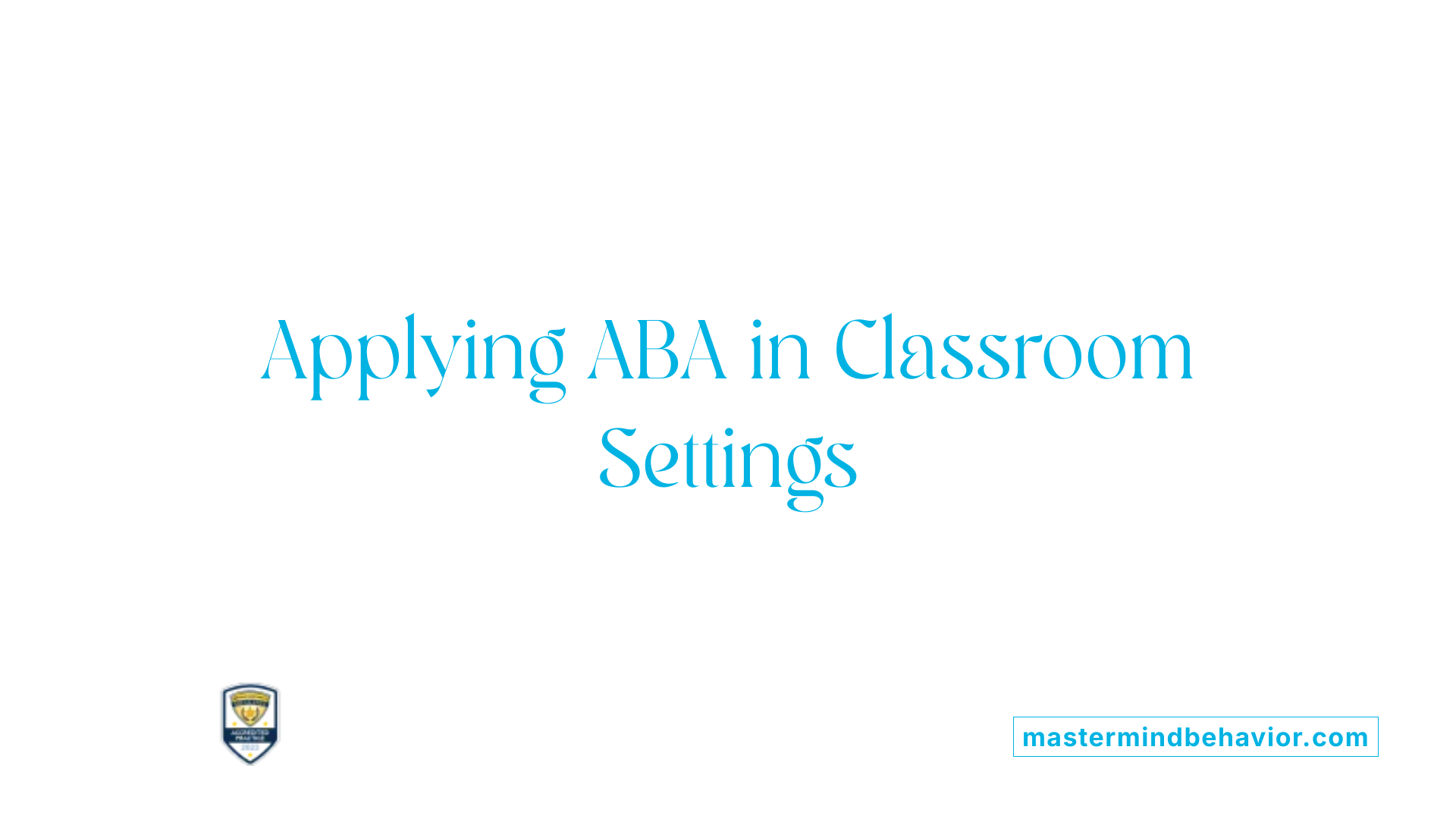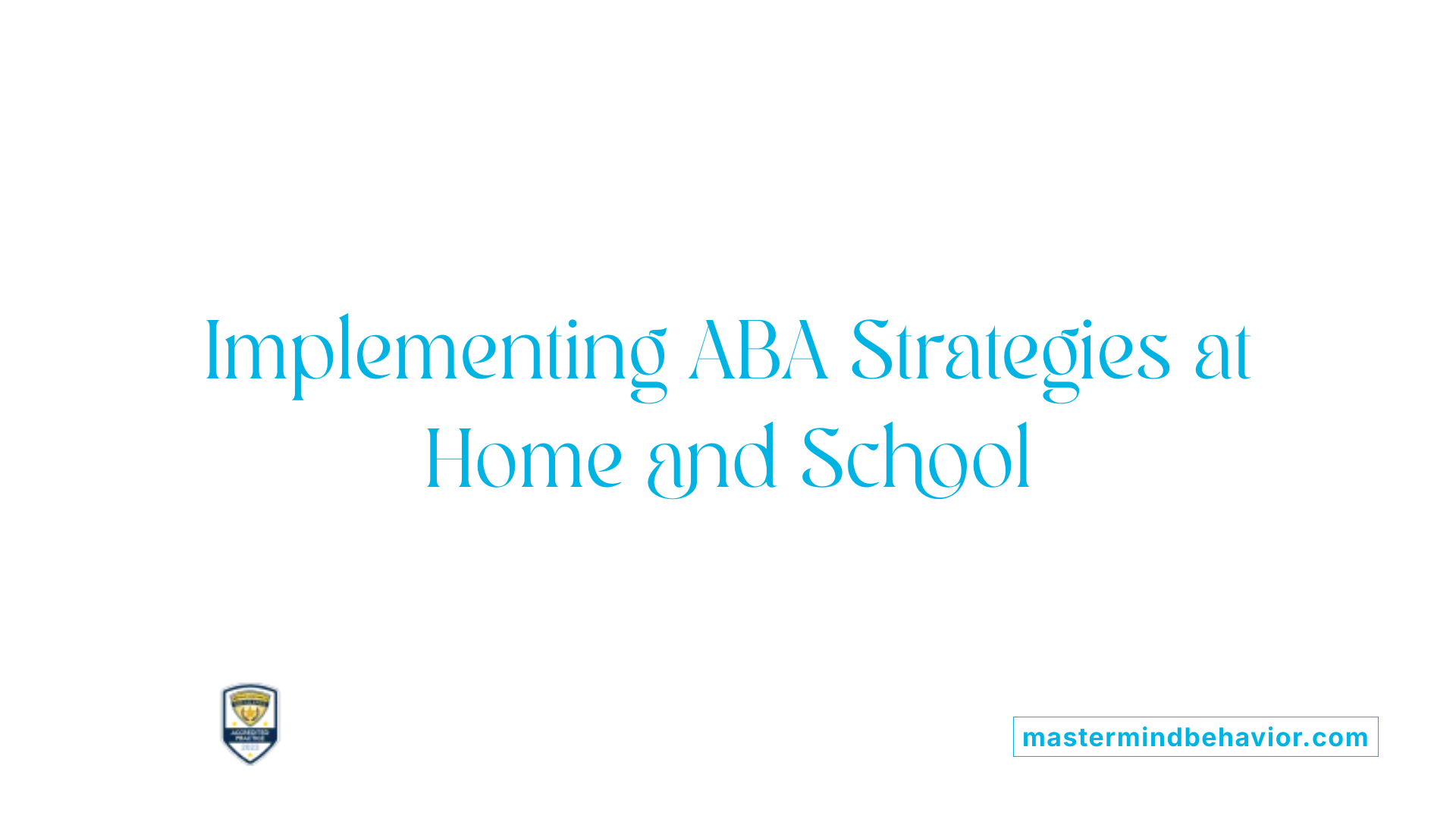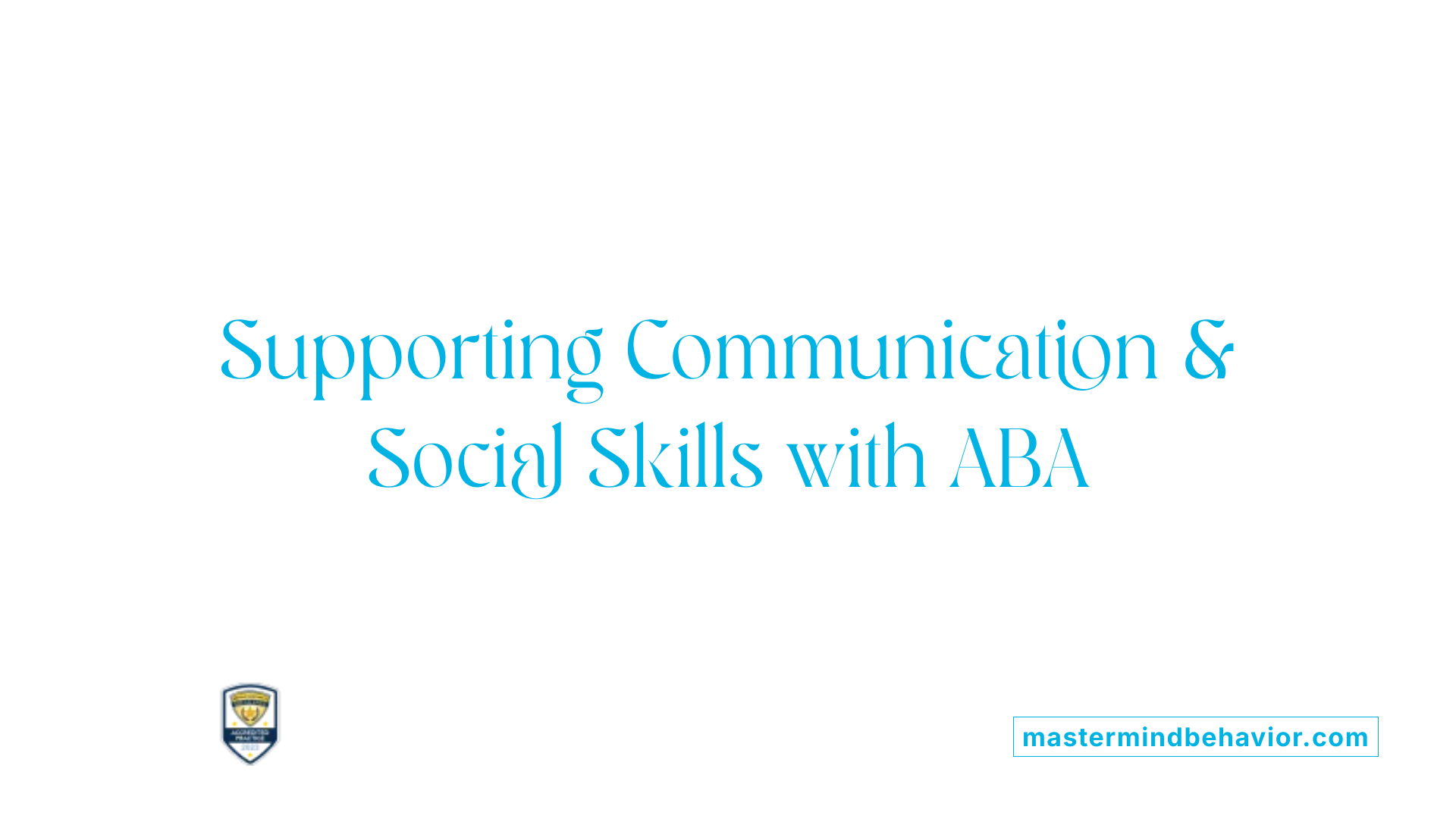Unlocking Effective Classroom Management Through ABA Techniques
Applied Behavior Analysis (ABA) offers a scientifically grounded framework for managing behaviors, teaching skills, and fostering positive classroom environments. This article explores how educators can leverage ABA principles to promote adaptive behaviors, support students with autism, and create learning spaces that are structured and engaging. By understanding the core strategies and data-driven practices inherent in ABA, teachers and parents can implement consistent, individualized interventions that enhance learning outcomes and behavioral functioning.
Fundamentals of Behavior Management in ABA

What is behavior management in ABA?
Behavior management in ABA involves the application of scientifically validated techniques aimed at increasing helpful behaviors and decreasing undesired or disruptive behaviors. This approach relies on understanding the influence of environmental factors on behavior and uses tailored strategies such as reinforcement, prompting, modeling, and environmental modifications.
In classroom settings, ABA’s primary goal is to support learners in developing essential communication, social, and daily living skills. Therapists and teachers observe behaviors closely, analyze patterns, and implement interventions that are specific to each individual's needs.
Key techniques include positive reinforcement, where desirable behaviors are rewarded to encourage their recurrence; prompting and fading to guide and then reduce assistance; and environmental adjustments that promote optimal learning conditions. Data collection and analysis are vital components, providing ongoing insight into behavior patterns and progress, enabling educators to refine strategies effectively.
Family involvement enhances the success of ABA programs. Caregivers are trained to reinforce skills at home, creating consistency across environments. Overall, behavior management in ABA aims to improve quality of life by fostering meaningful, functional behaviors that support independence and social participation.
Applying ABA in Classroom Settings

How can ABA be used in the classroom?
Applied Behavior Analysis (ABA) offers a practical, evidence-based framework for enhancing learning and behavior in educational environments. Teachers and behavior analysts work together to implement strategies that promote positive behaviors, communication, social interaction, and academic skills.
In daily routines, ABA techniques such as reinforcement and environmental modifications are seamlessly integrated. For example, positive reinforcement involves rewarding students with praise, tokens, or small treats to encourage desired behaviors. Token economy systems are especially effective, where students earn tokens that can later be exchanged for preferred activities or items, further motivating engagement.
Instructional methods like Discrete Trial Training (DTT) and Natural Environment Teaching (NET) break complex skills into manageable steps or capitalize on natural interests and routines. DTT involves clear, repeated instructions with prompted responses and reinforcement, making it ideal for teaching foundational skills. Conversely, NET encourages learning in real-life contexts by observing and engaging students during their everyday activities, promoting generalization.
A crucial component of ABA in education is performing functional behavior assessments (FBA). These assessments identify the purpose or function behind behaviors, guiding tailored interventions and individualized goals. Goals are set based on comprehensive assessments, ensuring they meet each student's unique needs.
Behavior analysts and classroom teachers collaborate closely, utilizing ongoing data collection to monitor progress. Data points include the frequency, duration, and type of behaviors, which inform timely adjustments to intervention strategies. Consistency and fidelity in implementing these techniques are vital for success.
Incorporating ABA into routines helps bridge skill acquisition across environments and supports students with autism and other developmental disabilities. When implemented early and with regular assessments, ABA leads to meaningful improvements in students' adaptive, social, and academic capabilities, fostering a more inclusive, productive classroom atmosphere.
Strategies for Managing Challenging Behaviors
What are effective strategies for managing challenging behaviors in children with autism?
Managing challenging behaviors in children with autism requires a comprehensive approach rooted in understanding individual needs and consistent application of evidence-based techniques. One foundational strategy involves establishing predictable routines and using visual supports, such as picture cards, social stories, and visual schedules. These tools help children understand daily expectations, reduce anxiety, and promote independence.
In addition, teaching coping and calming skills is vital. Techniques such as deep breathing exercises, sensory tools (like textured toys or calming scents), and self-monitoring methods enable children to manage stress and sensory overload effectively. These skills empower them to self-regulate in various settings.
Transitions and changes can often trigger challenging behavior. Providing children with advance notice and structured transition cues—supported by visual aids—can ease their adjustment and reduce disruptive reactions. Addressing sensory needs through appropriate activities and environmental modifications, like noise-canceling headphones or designated sensory zones, also supports emotional regulation.
Consistency across environments and caregivers enhances the effectiveness of these strategies. Reinforcing positive behaviors with praise and rewards encourages children to adopt adaptive coping mechanisms and build self-control. Overall, integrating visual supports, teaching self-regulation skills, and creating sensory-friendly environments form the core components of successful behavior management in children with autism.
Core ABA Interventions in Education
What are common ABA interventions used in educational settings?
Applied Behavior Analysis (ABA) offers a variety of effective interventions that support learning and behavior management in classrooms. These strategies are grounded in scientific research and are tailored to meet individual student needs.
One of the most prevalent techniques is positive reinforcement, where students earn rewards like praise, tokens, or privileges for demonstrating desired behaviors. This encourages ongoing engagement and skill development. For example, a student might earn a token for completing a task, which can later be exchanged for a preferred activity.
Token economies are a popular reinforcement system in classrooms. They involve distributing tokens or symbols that students collect and trade for bigger rewards, such as extra recess or special activities. This visual and tangible form of reinforcement helps motivate students and track progress.
In addition, prompting involves providing cues—verbal, visual, or physical—to encourage a specific behavior. As students begin to master a skill, prompt fading gradually reduces these cues, fostering independence. For example, a teacher might initially gesture to encourage a student to ask for help, then slowly decrease the prompts over time.
Task analysis breaks down complex skills into smaller, manageable steps. Teaching these steps sequentially makes it easier for students to learn and master routines like unpacking their bag or washing hands. This approach supports independence and systematic skill acquisition.
Behavioral chaining is related to task analysis, where individual steps are linked together into a complete routine. Forward chaining begins with the first step, while backward chaining starts with the last. These methods are effective for teaching daily routines, social skills, and other functional behaviors.
Incorporating visual supports like picture schedules, social stories, and charts further enhances understanding and communication. These cues help students anticipate what comes next and reduce anxiety.
Overall, ABA interventions in education blend reinforcement, prompting, task analysis, and visual supports to promote meaningful learning, positive behaviors, and independence for children with autism and other behavioral challenges.
Implementing ABA Techniques at Home and School

How do teachers and parents implement ABA techniques at home or in the classroom?
Applying ABA strategies effectively in both home and school environments involves several systematic approaches rooted in science. Establishing structured routines helps create predictability, reducing anxiety and promoting positive behaviors. Visual supports like charts, calendars, and task lists assist children in understanding daily schedules and expectations, thereby encouraging independence.
Reinforcement plays a central role in encouraging desired behaviors. Positive reinforcement—for example, praise, tokens, or access to preferred activities—is used immediately after the behavior to increase its recurrence. Conversely, prompts such as verbal cues, gestures, or physical guidance are employed to guide children toward appropriate responses. Over time, these prompts are gradually faded, fostering greater independence.
Activities like Discrete Trial Teaching (DTT) break down complex skills into small, manageable steps, each one taught with specific instructions, prompts, and reinforcement. Naturalistic teaching strategies embed learning within everyday routines and interests, helping children transfer skills across different settings.
Collaboration with trained professionals, including Behavior Analysts and Registered Behavior Technicians (RBTs), ensures that interventions are tailored to each child's unique needs. Professionals often conduct assessments and collect data to monitor progress, adjusting strategies as necessary.
Parents and teachers also reinforce routines using visual cues and modeling to demonstrate expected behaviors. Incorporating a child's interests into activities maintains engagement, while consistent practice of social and communication skills in real-life situations encourages generalization.
By integrating these techniques—structured routines, reinforcement, prompting, and professional guidance—parents and educators can create a supportive environment that fosters meaningful learning and positive behavioral changes.
Supporting Communication and Social Development with ABA

How does ABA support children with autism in developing communication and social skills?
Applied Behavior Analysis (ABA) utilizes a range of evidence-based techniques to foster communication and social skills. Central to ABA are reinforcement strategies—both positive and negative—that encourage desired behaviors. For instance, when a child appropriately initiates a social interaction or communicates a need, they receive immediate praise or tokens, boosting the likelihood of repeating that behavior.
Structured teaching approaches, such as Discrete Trial Training (DTT), are often employed to teach specific skills in small, manageable steps. These involve clear instructions, prompts, and reinforcement, allowing children to learn effectively at their own pace. Additionally, naturalistic teaching and incidental learning capitalize on children’s interests and routines, integrating skill acquisition into everyday activities. This method promotes functional communication, making skills relevant and useful.
ABA therapists analyze behavior chains and the function of behaviors by examining antecedents and consequences. By understanding what motivates behaviors, educators can reinforce positive social and communication attempts while reducing challenging behaviors through strategies like extinction and redirection.
Visual supports such as picture exchange systems, charts, and social scripts further enhance comprehension and participation. Consistent routines and environmental modifications, including preferred seating and visual schedules, create predictable environments conducive to social interactions.
Overall, ABA helps children achieve independence and improve their quality of life by systematically teaching socially meaningful behaviors and communication skills. Through a combination of structured interventions, incidental learning, and reinforcement, children with autism learn to engage better with their peers and adults, laying a foundation for lifelong social competence.
Building a Positive Classroom Environment with ABA

What are common ABA strategies used in educational settings?
Applied Behavior Analysis (ABA) offers a variety of strategies that help create effective and supportive classroom environments for students with diverse needs. One of the foundational techniques is positive reinforcement, which involves rewarding students with praise, tokens, or privileges to encourage desired behaviors. This approach builds motivation and promotes learning.
Prompting and prompt fading are additional tools used to support skill acquisition. Teachers provide cues—such as verbal, visual, or physical prompts—to guide students through new tasks, then gradually reduce these aids to foster independence.
Task analysis breaks down complex skills or routines into small, manageable steps. This method simplifies learning processes, making it easier for students to master activities like self-care or classroom routines.
Visual supports like picture schedules, visual timers, and social stories help students understand daily routines and expectations, reducing anxiety and increasing participation. Token systems, where students earn tokens or symbols exchanging them for rewards, serve as motivational tools that reinforce positive behavior consistently.
ABA techniques also extend to teaching social skills, communication, self-care routines, and promoting independence in areas such as toileting and sleep routines. Data collection, often involving parents, tracks progress and guides the adjustment of teaching strategies.
Overall, these ABA strategies foster a proactive, positive, and inclusive classroom atmosphere that encourages growth, builds independence, and minimizes disruptive behaviors.
Use of visual supports and reinforcement
Utilizing visual supports in the classroom enhances understanding and reduces confusion for learners, especially those with autism or language delays. Written words, pictorial cues, and visual timers create predictable routines, helping students anticipate transitions and activities.
Reinforcements—such as praise, small treats, or tokens—are delivered immediately after appropriate behaviors, making it clear which actions are desirable. These rewards motivate students to repeat positive behaviors and participate actively in learning.
Token economy systems can be tailored to individual students, providing a tangible representation of their achievements, which they can exchange for preferred items or activities. This reinforcement strategy increases engagement and promotes consistent behavior.
Fostering inclusive and cooperative social interactions
Creating an environment where students feel included and can interact positively is vital. ABA emphasizes promoting social initiations, turn-taking, and cooperative play. Techniques like scripts and choral responding guide children in practicing social scenarios, boosting their confidence and skills.
Encouraging positive peer interactions through structured activities helps foster friendships and social understanding. Establishing clear, simple expectations and using visual and behavioral supports reinforce appropriate social behaviors.
The CMS Approach incorporates teacher training on ABA principles, emphasizing differentiation and prompting strategies that nurture inclusive, cooperative environments. This fosters positive relationships and supports the social-emotional development of all students.
| Strategy | Implementation Example | Benefit |
|---|---|---|
| Positive Reinforcement | Praise or tokens for good behavior | Increases desirable behaviors |
| Visual Supports | Picture schedules, social stories | Clarifies routines and expectations |
| Token Economy | Tokens exchanged for rewards | Motivates sustained engagement |
| Choral Responding and Scripts | Guided responses during lessons | Supports communication and participation |
| Social Skills Training | Structured peer activities | Enhances social interactions and friendships |
Using these approaches, educators can cultivate a classroom that is predictable, engaging, and supportive, fostering success for all students.
Fostering Skill Development and Positive Behavior Through ABA
Implementing ABA in the classroom requires a thoughtful, consistent approach, emphasizing positive reinforcement, structured routines, and data-driven decision-making. By tailoring interventions to individual needs and involving families, educators can create supportive environments that promote meaningful learning, social interaction, and adaptive behaviors. The collaborative effort among teachers, therapists, and families ensures that behavioral goals are met and that children with autism and other challenges experience improved quality of life and increased independence. As research continues to validate ABA's effectiveness, its strategic application in educational settings remains a cornerstone of effective classroom management, empowering both students and educators to thrive.
References
- How to Use ABA in the Classroom
- ABA Techniques: Strategies for Behavior Analysts - GSEP Blog
- Effective ABA Strategies for Students with Autism - TeachTown Inc.
- [PDF] Integrating Evidence-Based Practices & ABA Principles in the Early ...
- 10 Effective ABA Behavior Management Strategies - Ori Learning
- How to Use ABA to Manage Challenging Behaviour in the Classroom
- Applied Behavior Analysis (ABA) | Autism Speaks
- How To Implement ABA In The Classroom - The Autism Helper
- 9 Proactive ABA Methods to Redirect Student Behavior
- ABA Classroom Management Systems | Effective School Solution









